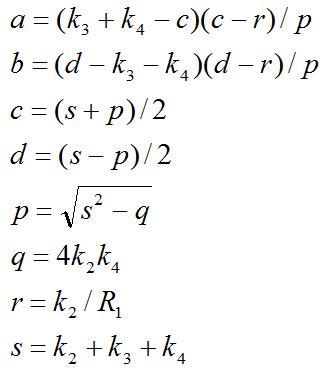Model Configuration and Assumptions
The Full Reference Tissue method (or 4 Parameter Reference Tissue Method) of Lammertsma et al. is used for the analysis of studies with reversibly binding neuroreceptor tracers. A reference tissue devoid of receptors is required which can be modeled by a single-tissue compartment model. Tissues of interest which include the target receptor are modeled by a 2-tissue compartment model.

In the model equations CT'(t) represents the tissue TAC from the reference region (k3=0 in the 2-tissue compartment model), and CT(t) the tissue TAC from a receptor-rich region (k3>0). It is assumed that the distribution volume of the non-displaceable compartment is the same for tissues of interest and the reference tissue: K1/k2=K1'/k2'. Furthermore the reference tissue should not affected by the pathology investigated under study.
Operational Model Curve
Defining the ratio of tracer delivery R1 as K1/K1' and the binding potential BPND as k3/k4, the following operational equation can be derived for the measured tissue TAC in a receptor-rich region:
![]()
The equation parameters and their relation to the model are given by:

For convolution with the exponentials, the reference tissue TAC CT'(t) is resampled on a regular grid, which can be specified by the Resampling parameter.
Parameter Fitting
The operational equation includes four unknowns: R1, k2, k3, and BPnd (after substitution of BPND=k3/k4), which can be fitted using nonlinear fitting techniques.
Reference
Lammertsma AA, Bench CJ, Hume SP, Osman S, Gunn K, Brooks DJ, Frackowiak RS: Comparison of methods for analysis of clinical [11C]raclopride studies. J Cereb Blood Flow Metab 1996, 16(1):42-52. DOI